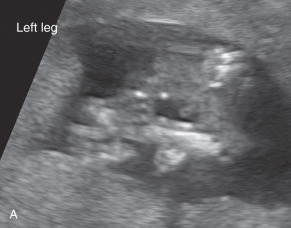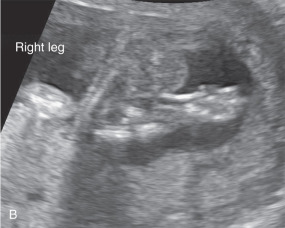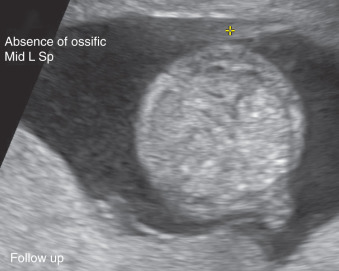Abstract
Caudal regression syndrome (CRS), also known as caudal regression sequence, caudal dysplasia, caudal apalasia, femoral hypoplasia, phocomelic diabetic embryopathy, or sacral agenesis, is a spectrum of anomalies involving the caudal trunk. The frequency is about 1:10,000 live births, and maternal hyperglycemia markedly increases the risk. Abnormal differentiation of the developing spine, spinal cord, and caudal mesoderm is the pathogenesis. Classically, it appears as the sudden interruption of the spine with abnormal positioning or hypoplasia of the lower extremities on ultrasound assessment. Associated anomalies are common and include gastrointestinal, genitourinary, and others. The prognosis depends on the level of spinal termination and associated anomalies. No intrauterine treatment is available. Patients who chose to continue the pregnancy should have consultation with pediatric subspecialists.
Keywords
skeletal dysplasia, anomaly, short long bones, dwarfism
Introduction
Caudal regression syndrome (CRS), also known as caudal regression sequence, caudal dysplasia, caudal aplasia, femoral hypoplasia, phocomelic diabetic embryopathy, or sacral agenesis , is a spectrum of anomalies involving the caudal end of the trunk. The pathogenesis involves abnormal differentiation of the developing spine, spinal cord, and caudal mesoderm. Although CRS is rare in the general population, maternal hyperglycemia is thought to play an important role, and the malformation is seen much more commonly in infants of diabetic mothers. Associated malformations are common, particularly those in the genitourinary tract.
Disease
Definition
CRS comprises various degrees of anomalous formation of the caudal trunk. The spectrum of disease can vary from isolated partial agenesis of the sacrococcygeal spine to complete absence of sacral, lumbar, or lower thoracic vertebrae. Although complete sirenomelia is considered by some authors to be part of the spectrum, many authors now consider complete sirenomelia to be a separate category.
Prevalence and Epidemiology
The frequency is estimated to be 1.3 : 10,000 births. No gender predominance has been reported. Although CRS is not limited to infants of diabetic mothers, it occurs 200 times more frequently in these infants than in the general population.
Etiology and Pathophysiology
The caudal eminence, or tailbud, is a mass of pluripotent tissue distinguished early in embryogenesis as a continuation of the primitive streak. It ultimately gives rise to all the tissues of the caudal embryo, including the primordia of the genitourinary system, the hindgut, the neural cord and crest cells, and somites. Various abnormalities that result to this structure through a combination of genetic and stochastic events, occurring before the fourth week of gestation, are thought to result in the spectrum of caudal regression.
The most common teratogen implicated in this process is hyperglycemia owing to maternal diabetes; poor glycemic control is a known risk factor. Some form of CRS has been estimated to occur in 1% of infants born to diabetic mothers. CRS has also been associated with more subtle levels of glucose intolerance even without overt diabetes. Other proposed contributing factors include genetic predisposition, vascular anomalies altering blood flow, and drugs or other environmental exposures. Cases have been reported after exposure to minoxidil, trimethoprim-sulfamethoxazole, and tocilizumab. CRS is likely caused by a combination of factors including genetic disposition combined with an epigenetic event. With rare exceptions, the fetal karyotype is normal.
Some investigators have described rare familial occurrences with suspected autosomal recessive inheritance. The HLXB9 gene has been implicated in some cases of autosomal dominant form of sacral agenesis, Currarino syndrome or Currarino triad, which is an association of partial sacral agenesis with intact first sacral vertebra (sickle-shaped sacrum), a presacral mass, and anorectal malformation, as well genitourinary abnormalities. There is variable penetrance of this disorder.
Manifestations of Disease
Clinical Presentation
Characteristic features include short intergluteal cleft, flattened buttocks, narrow hips, distal leg atrophy, and talipes deformities. Urinary and bowel dysfunction are nearly universal. Motor function is generally more affected than sensory function and is correlated with the level of spinal aplasia. In very mild cases, such as isolated coccygeal agenesis, patients may be asymptomatic.
Associated anomalies are common, often involving abnormalities of the genitourinary tract, hindgut, cardiac, and respiratory system. CRS has been associated with OEIS ( o mphalocele, e xstrophy, i mperforate anus, and s pinal defects) and VATER ( v ertebral defects, imperforate a nus, t racheo e sophageal fistula, r adial and r enal dysplasia) ( Chapter 146 ) associations. Sirenomelia is often associated with renal agenesis and pulmonary hypoplasia and thus is fatal in such cases. Prognosis largely depends on associated anomalies and the level of spinal involvement. Intelligence and mental function generally are preserved.
Imaging Technique and Findings
Ultrasound
Classic findings on prenatal ultrasound (US) are sudden interruption of the spine with absence of vertebrae and frog-leg position of the lower limbs ( Fig. 59.1 ). The position of the lower limbs has also been termed cross-legged tailor or Buddha pose.


First-trimester US findings suggestive of the diagnosis include short crown-rump length, protuberance of the lower spine, and increased nuchal translucency. The diagnosis has been suspected at 13 weeks’ gestation but is usually not detected until the mid-second trimester because the sacrum is not fully ossified until approximately 18 weeks. High-resolution vaginal US may be useful in the first trimester.
Findings described later in gestation include abrupt termination of the spine at various levels (low thoracic, lumbar, or sacral levels), short femora, and abnormal lower extremity positioning. Although CRS may be best visualized on sagittal imaging, axial or coronal views of the fetal spine also show a lack of bony ossification ( Fig. 59.2 ). The sacrum has been described as “shield-shaped” in CRS with the iliac wings fused and decreased distance between the femoral heads ( Fig. 59.3 ). Also, the femora may be held in a fixed V shape ( Fig. 59.4 ) and often show no or abnormal movement. Careful attention should be paid to the level at which the spine ends, and this may be best visualized on sagittal imaging ( Fig. 59.5 ). In some cases, the spine can appear to “taper,” and this should not be misinterpreted as a normal sacrum. On routine US, normal transverse views should show spinal ossification centers at the level of the iliac wings.











